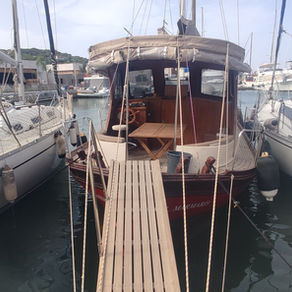Periodic Engine Maintenances
- Burak Kaan Yıldız

- Aug 18, 2021
- 2 min read
Updated: Feb 15, 2022
The simplest, cheapest and easiest way to ensure that the engines used in marine engines do not fail is to carry out and follow the standard and periodic maintenance written in the engine's manual without interruption.
In marine engines, the maintenance phase becomes even more important due to the more difficult physical conditions the engine is exposed to and the magnitude of the dangers to be encountered in the event of a breakdown. Remember; The worst maintenance is better than the best repair.
What should be paid attention to?

1. Keep the engine and engine room clean. Dirt, oil and rust on the engine can prevent problems from being detected early.
2. Obtain your diesel from reliable places. Make sure that it is clean and not mixed with water. Do not store the fuel in the spare can for a long time, keep your tank full.
3. Close the fuel filler cap on the deck properly. It may cause rain or sea water to enter the tank.
4. Check the engine phsically, oil and water before each start.
5. Check the exhaust as soon as you start it up. see if there is smoke
6. Warm up the engine before starting
7. Do not crank for a long time (>20sec)
8. Do not sail at full speed for a long time
9. Let the engine idle for a while before stopping.
10. Read the user manual, do not interrupt engine maintenance.
Before Starting The Engines
1. Is the engine battery pack switch open? Check
2. Is the throttle in neutral? In gear? Check.
3. Turn the engine panel switch to the “on” position.
4. Alarms (oil pressure and charge) will turn on when the engine panel is powered.
5. Activate glow plugs, if any. Pressing for 10 seconds in the summer and 20 seconds in the winter will be sufficient.
6. Cold and old, worn engines may not start immediately. Throttle halfway.
7. Check the gauges (tachometer, fuel level, voltmeter if available, and amperage charge) on the engine panel. With operation, alarms should be silenced.
8. Check the water and smoke discharge from the exhaust. It is natural to have some smoke in cold weather.
Although there are slight differences between the engines, the standard maintenance of a marine engine does not vary much, regardless of the brand and type.
Every 15 days
1. Separ filter control. Draining the water, if any.
2. Check the belts tension, integrity, etc.
3. Check the seawater filter,
4. Condition and level of the battery liquid
5. Transmission oil and level
6. S-drive oil and level
Every 200 working hours or annually (whichever comes first)
1. Engine oil change
2. Oil filter change
3. Transmission oil change
4. S-drive oil change
5. Corrosion condition of transmission and S-drive
Every 500 working hours or annually (whichever comes first)
1-Fuel filter change
2-Separ Filter control/change
3-Idle setting control
4-Seawater pump and impeller control/change
5-Seawater filter cleaning
6-Changing the coolant and antifreeze
At least once a year
1- Cleaning the folding propeller (if any)
2-Checking the gasket of the S-drive
Every 500 working hours and/or every 2 years
1-Air filter change
2-Injector control
3-Control of the cooler
4-Valve adjustment
After every 500 operating hours or every 5 years,
The S-drive gasket should be replaced every 7 years.







Comments